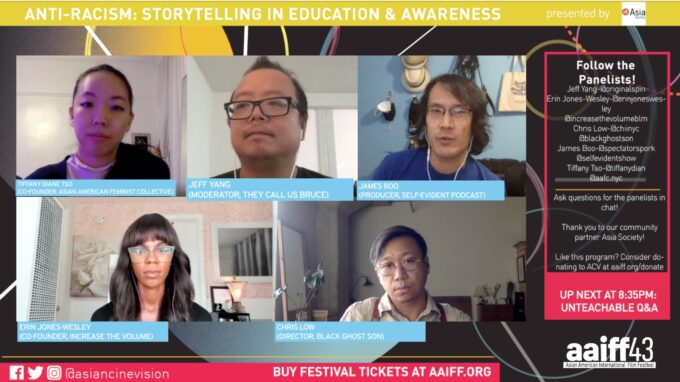The POC mediamaker’s how-to guide on anti-racism
Written By: Demi Guo
Between podcasting, the news and entertainment, all media representation is tied to real-life consequence. In order for representation to further combat racism, said the AAIFF panel on Tuesday night, creators must re-examine old tropes.
“Like when you find out the bad guy’s a Nazi,” James Boo, host of the “Self Evident” podcast, said. The United States has seen a rise in white supremacist activities under the Trump administration, which often includes the neo-Nazi movement. However, in media, a Nazi is still presented as a villain of the past, without any allusion to its ongoing legacy. “Those dots are not connected that much. Even on TV, it’s such a cartoonish representation.”
Jeff Yang, host of the “They Call Us Bruce” podcast, coined a term for it. “It’s too easy to put the responsibility of racism on the looming Nazi in the background,” he said.
Media is therefore lacking in real-life context, according to Erin Jones-Wesley, co-founder of “Increase the Volume.” It is because of established media trends in an industry that has historically been segregated and white-dominated.
The white perspective is the standard for objectivity across the board, Yang said. The news, for example, is told with a “dispassionate voice that normalizes the establishment, and tells people of color they’re too close to those stories, because they are too subjective.”
That an Asian American can tell their own story in this day and age, Yang said, is a huge step forward. But journalist Tiffany Diane Tso is cautioned against the other extreme, where she is relegated to writing only about Asian American issues. “Those are the stories editors are interested in seeing me write. I’m glad people can read about our issues,” she said. However, she added, the voices of people of color should be normalized across the board, not just for one static purpose.

One way to break this tradition is to show mundane, everyday situations that audiences can encounter in their own lives, Jones-Wesley said. “It’s really just showing people as they are, and show them in their natural setting,” she said.
Jones-Wesley cited a scene from Issa Rae’s “Insecure,” where the character Molly and her Asian American boyfriend discussed their interracial relationship. “[For example:] ‘Your brother might have said something that didn’t fit,’” Jones-Wesley said. “People in real life would be able to emulate that, and they’re able to have an uncomfortable conversation.”
Intersectional bridge-building between minorities is part of progressing representation. Chris Low talked about confronting anti-Blackness in the Asian community in his film, “Black Ghost Son.” The synopsis is about the identity struggles of a Black American child growing up with an Asian American father, a situation which Low took from his own life. “They inherit prejudice,” Low said, “or the inherited prejudice that he himself is not aware of.”
Tangentially, Jones-Wesley said, mindful representation applies to people from all walks of life you don’t talk about in polite company. The main character from Justin Chon’s “Ms. Purple” is an Asian woman in sex work — which has become a caricature in classics like “Full Metal Jacket” and “Miss Saigon.” However, unlike this pattern, “Ms. Purple” gives the character a motivation and three-dimensional personality. “Did we do the work to build that character?” Jones-Wesley said. Is the Asian woman talking? Is she humanized, not just as an Asian woman, but as a woman in sex work?
When they opened the panel, Yang reacted with enthusiasm to So’s presence — that she is an Asian American journalist reporting on Asian American issues. Taking ahold of one’s own narrative is a huge departure from where he started in the industry, he said. It’s just that there’s more work to be done.
“In real life,” Jones-Wesley said, “if we’re not doing it, we’re not doing the work of being anti-racist.”

